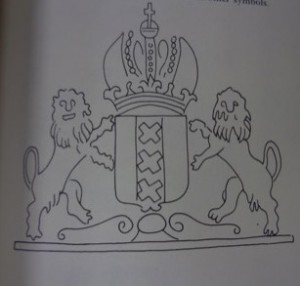 Montebourg Manuscript wrapper (Collection of French Language Manuscripts, 1633-1942, Mss. 1.17)
Montebourg Manuscript wrapper (Collection of French Language Manuscripts, 1633-1942, Mss. 1.17)
When a 1633 French legal document was donated to Special Collections, a creased, torn, dirty piece of paper was wrapped around it. This wrapper may seem like something that should be thrown away, but it has its own stories to tell.
In the first place, there is the text on the outside. It was written by someone other than the author of the document, but still some time ago. This inscription tells us that the legal papers within relate to the abbey of Montebourg in Normandy. As a historical side-note, most of the places mentioned in the document were within striking distance of what would be called Utah beach on D-Day.
The paper itself provides another piece of the context of this manuscript: it was made from rag, not tree pulp. European paper was made in this way until the early nineteenth century, although at different levels of quality. This is quite good paper, and it has a watermark:
 Montebourg Manuscript watermark
Montebourg Manuscript watermark
At the center of the watermark is a shield with three crosses in a vertical line, supported by two lions on either side, and topped by a crown. These are the arms of Amsterdam, and they are found on paper made in the Dutch Republic in the seventeenth and eighteenth centuries, but also on some papers made in France. This may explain why the crown is not the traditional imperial crown, as seen in this image from Philip Gaskell’s A New Introduction to Bibliography[1]:
 Image from "A New Introduction to Bibliography" by Philip Gaskell
Image from "A New Introduction to Bibliography" by Philip Gaskell
In 1671 the Dutch government forbade the importation of French paper and encouraged local manufacture with technology based -- like much else in the Netherlands -- on windmill power. According to Lucien Febvre and Henri Martin in their L’apparition du livre, translated as The Coming of the Book, this resulted in “higher output and better quality,” which may explain why French papermakers copied these watermarks: it’s always easier to sell something at a higher price if it is said to be imported and of higher quality.[2]
Although this "paper-trail" doesn’t tell us everything about the document, it shows that someone in Normandy thought that it was worth keeping, and worth wrapping in paper which may have come from a city 500 miles away.
[1] Philip Gaskell, A New Introduction to Bibliography (New Castle, DE: Oak Knoll Press, 2012), Reprinted with corrections in 1995.
[2] Lucien Febvre and Henri-Jean Martin, The Coming of the Book: The Impact of Printing 1450-1800, (London: N.L.B., 1976).